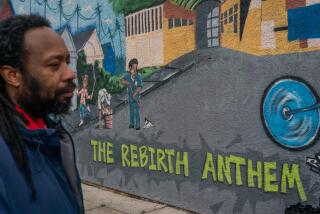Makers of film on Oakland’s recyclers await word from Sundance
OAKLAND — Amir Soltani moved into his brother’s townhouse eight years ago in a new West Oakland development touting itself as a bridge between “industrial and residential neighborhoods.”
He had fled Iran as a child for a life of relative privilege in Britain and the U.S., where he attended elite colleges. Yet Soltani understood displacement and the outsider’s lack of belonging. And he saw and heard something he could not ignore.
The clang clang of the shopping carts formed a spectral nighttime symphony as recyclers congregated from miles around. Some pushed loads of as much as a thousand pounds on rigs lashed together with street ingenuity. Their destination: Alliance Recycling.
Local residents had long clashed with Alliance, and transplanted professionals who bought into the townhouse complex were even more vocal in their displeasure. The sounds were cacophonous, and the cash disbursed for glass and aluminum pilfered from private cans was often spent on drugs, booze and sex in plain sight.
Soltani saw a bigger picture: the legacy of poor urban planning that had turned a thriving African American enclave into a destitute landscape pocked by industry. And now, gentrification and mounting tensions.
He quit his job, bought a camera and became a fixture at Alliance.
Six years later, “Dogtown Redemption,” the documentary he created with co-director and cinematographer Chihiro Wimbush, is in the hands of judges who will announce this week whether it wins a coveted slot in the Sundance Film Festival.
The duo hopes to spur discussion with an online interactive map on which residents and business owners can track recyclers’ routes and upload their own stories and opinions.
“It’s film as a way to build community,” said Soltani, 47. “There are all these people living at different levels here — sort of like a shattered mirror.”
Even before the film’s release, the long act of making it would prove transformative — for subjects and filmmakers: Lives lost. Recovery. Despair. And most of all, deep, abiding human bonds.
“I love Amir,” said Hayok Kay, 59, a South Korean-born former punk rock drummer whose mental health demons have kept her on the streets for decades. “Because he’s Amir.”
::
Soltani studied social and intellectual history at Tufts and Harvard universities, became a human rights activist and worked as a journalist before landing a Bay Area job here as Middle East editor for New America Media.
Around the corner from his new home was Alliance, which opened in 1978 — after redevelopment made its mark.
Freeways that promised connection to San Francisco had surrounded and isolated West Oakland. The depot at the western terminus of the First Transcontinental Railroad, which had brought in a flow of Southern job-seekers and cash-flush black porters, was closed.
A vibrant blues music scene died out, along with black-owned businesses that had offered a path to the middle class.
Alliance, in the neighborhood known as Dogtown, was a stage on which enduring consequences played out. Soltani settled in to watch and listen.
In mid-2008, he was joined by Wimbush, who, born to a Japanese mother and white father raised in Kenya, shared Soltani’s outsider perspective of urban America.
Where many saw dank and sticky chaos, the pair found the underside of the green economy and a subculture of enterprise, where recyclers closely guarded routes built on long-cultivated relationships.
On a recent day, Roslin Brister-Sanders, 56, showed off a heavy ring of keys around her neck that grant access to garages and gates along the two-mile route she has traced with her cart for more than a decade — first with her husband, and then alone, after he landed in jail and died under mysterious circumstances.
“People think we’re robbers, stealers, drunks,” Brister-Sanders said. “This film sheds some light on what we do. It’s showing that we are all taking part in society.”
::
Because of the heavy load she pulls, Brister-Sanders is the only woman welcome to join the self-titled “Breakfast Club” that gathers before dawn outside Oakland’s E-Z Liquors. Wimbush, 44, regularly met her there, the cup of coffee she requested steaming in his hands.
He has taken her to the hospital for bronchial infections more times than he can recall. “They can be sweet as gold or a pain,” Brister-Sanders said of the group. “They haven’t missed one of my birthdays. They always bring me a cake.”
Wimbush and Soltani bonded with “Miss Kay,” the former drummer, after her longtime partner — a street artist — succumbed to chronic illness. They tracked her journey from crippling grief to a stint in a shelter, then back to the streets and, recently, to newfound companionship.
They bore witness as Jason Witt, known as “the titan” for his monstrous rig, battled heroin addiction — and found his way back to a grounding childhood discipline: martial arts.
Then there is Landon Goodwin, 58. Born to a family of ministers, he ended up addicted on the streets, in and out of prison, “hanging around with people who were in the same position and same condition.”
In lengthy chats, he told the filmmakers he had never lost touch “with that inner person I really was” but had failed to fulfill his destiny. Soon after, he was beaten with a lead pipe. But those conversations stayed with him.
“You can’t have a film called ‘Redemption’ where nothing is redeemed,” said Goodwin. “Sometimes people kind of jump-start something that’s in you. I didn’t want to die on the streets. I wasn’t raised there.”
He entered recovery in Vallejo, and, as Wimbush and Soltani stood by, became an ordained minister, fell in love and married.
Soltani shared his own stories. When his fictional graphic novel, “Zahra’s Paradise,” was published in 2011, Brister-Sanders and Miss Kay both clamored for a copy. Set in the aftermath of Iran’s fraudulent 2009 elections, it tells of the search by a mother and brother for Mehdi, a protester who vanished into an extrajudicial twilight zone.
The displacement, grief and trauma experienced by Iranians, Soltani said, resonated.
Still, the closeness with their subjects came as a surprise.
“The way they have shared their stories, it’s a tremendous gift,” Soltani said. “The most humbling for me has been realizing that there are no easy solutions, no easy answers.”
::
As the pair scraped for funding, they found a warm reception.
Tere Romo, who oversees the San Francisco Foundation’s Bay Area documentary fund, said judges selected the project for going beyond an exploration of recycling to offer an intimate look at the humanity of the recyclers and the challenges they face.
The Sundance Institute — which receives more than 1,500 applications a year and funds about 50, chose it for its focus on “homelessness, addiction, gentrification — problems facing lots of municipalities,” said documentary film fund director Rahdi Taylor. It was afterward — when she met Soltani and Wimbush — that Taylor said she was so struck by “the open heart that they have.”
Sometimes, she said, where the public and private sectors fail, “artists can succeed in finding a new pathway to tell a different kind of story, to open a new window for a different kind of future.”
Goodwin put it this way: “I hope it brings attention to some of the homeless people who are out there who are pearls. You just never know until you get to know somebody what their potential really is.”
More to Read
Start your day right
Sign up for Essential California for news, features and recommendations from the L.A. Times and beyond in your inbox six days a week.
You may occasionally receive promotional content from the Los Angeles Times.







